


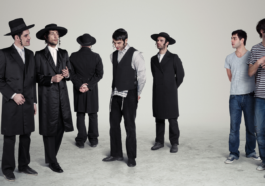
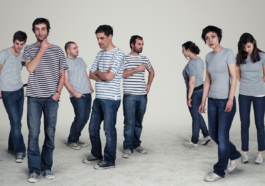

PHOTOGRAPHY, 2010
C-PRINTS, COLOR, 3P. 90X130
In their work “In the Name Of”, Borjana Ventzislavova and Mladen Penev study the phenomenon of submission to various norms and ideals, as represented in the outward appearances and dress codes of representatives of three different cultural and religious groups: Orthodox Jewish men, Western men and women, and Muslim women. The project’s focus is on the way these groups represent themselves, and on how we imagine and perceive them.
Do not the mechanisms that assert strict traditional, religious, or totalitarian norms and those of a society that believes itself to be free and democratic while functioning in accordance with the laws of global capitalism lead to similar phenomena of uniformity?
In contradistinction to Western culture, the dress codes by which Orthodox Muslim or Jewish believers abide would seem to be highly standardized and not particularly multifaceted. But are we not similarly subject to a diktat, that of global capitalism and mass consumerism? Have advertising and money taken the place of faith and religion?
WORK BY:
BORJANA VENTZISLAVOVA & MLADEN PENEV
ON GOING, 2010
C-PRINTS, COLOR, 17P. 42X28 cm
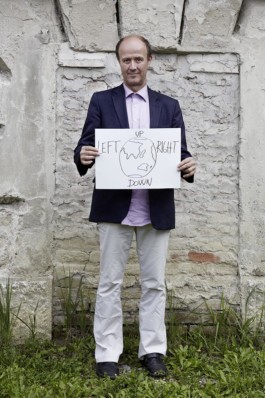
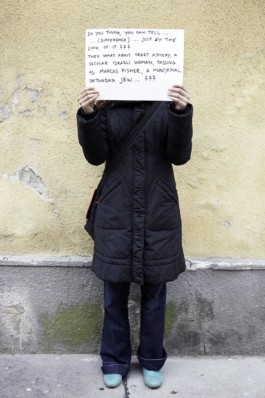
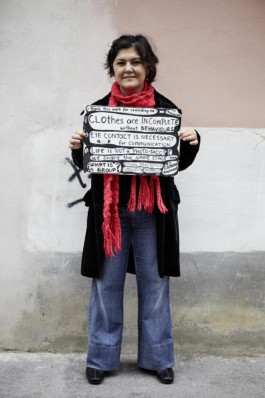
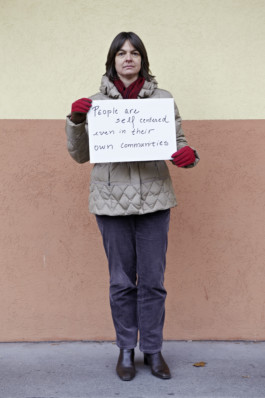
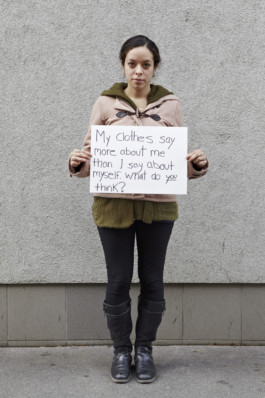
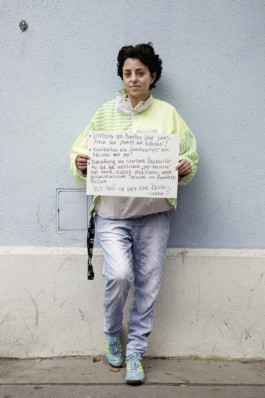
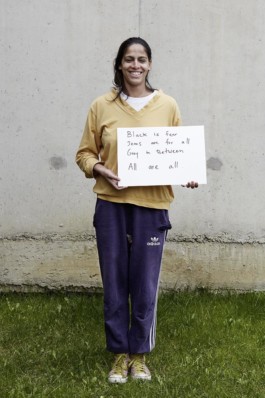
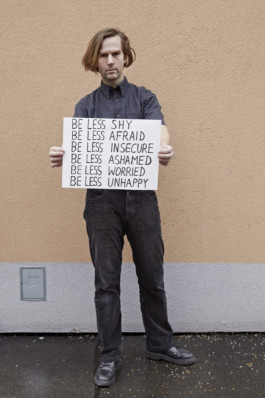
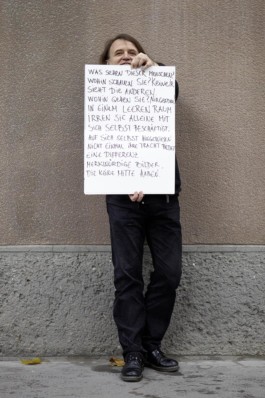
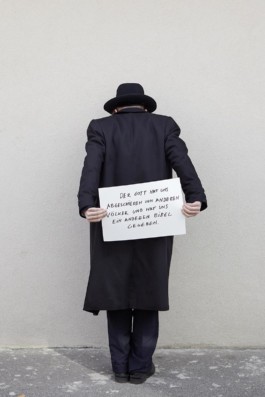
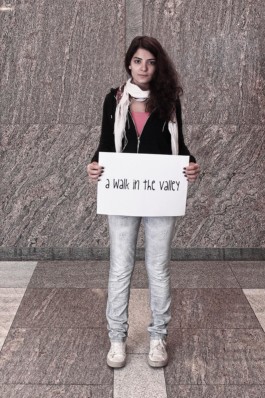
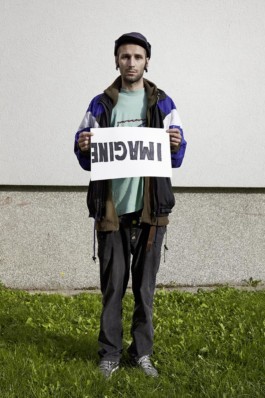
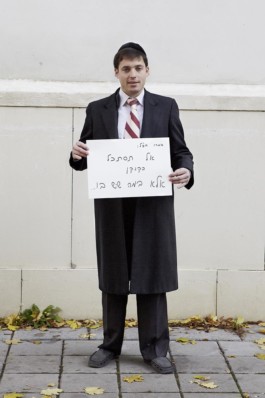
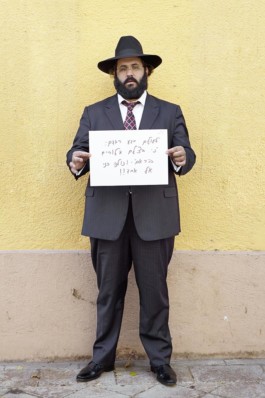
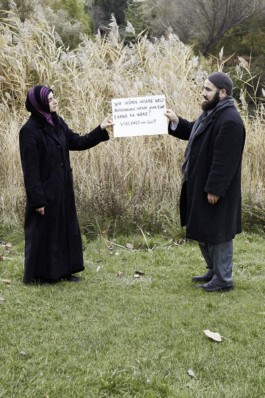
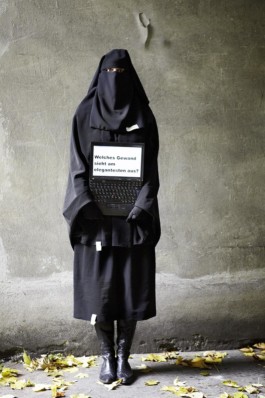
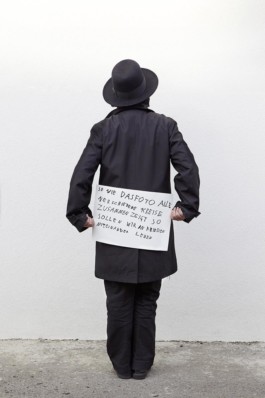
_
In their work In the Name Of, Borjana Ventzislavova and Mladen Penev study the phenomenon of submission to various norms and ideals, as evidenced in the outward appearances and dress codes of representatives of three different cultural and religious groups: Orthodox Jewish men, Western men and women, and Muslim women. The project’s focus is on the way these groups represent themselves, and on how they are perceived by an outside observer, how much freedom we in fact have, between social and cultural norms and expectations, to express ourselves and our belonging to certain communities in terms of clothing.
In the Western secular collective imagination Orthodox Muslims or Jews dress according to strict standards imposed by tradition, leading to a uniform group appearance, in contrast to individual fashion choices following various lifestyles offered by the free market and mass production in the democratic West. But do not the mechanisms of global capitalism themselves lead to phenomena of uniformity and even more accentuated homogenizing based not only on dress code, where dissent and subaltern identities are not well perceived? Even if Western individuals seem to have overcome clothing norms based on tradition, religion or gender, is their taste not subject to a command, ruled by a fashion industry producing demand through advertising and the mass media? And is not their outfit and image determined by certain ideological signs of integration and consumerism as they are supposed to represent ideas of health, mobility, flexibility, individual freedom, pluralism, liberalism and sexiness rather than real autonomy, heterogeneity and multiplicity? The work deals with the way the economic regime of the gaze tends to perceive the other (the one who does not belong to the respective group) in the limited scope of the field of vision. These perceptions are determined by generalizations based on anthropological and sociological stereotypes and their images embedded in projections and the imagination regarding the Other, which defend the beholder’s own cultural or social belonging and leads to exotization or lack of perceived difference and recognition of singular beings within another culture in which all look the same, as a result of racial, cultural, ethnic, religious reasoning overlapping with economic factors, and the system of production and distribution.
Text: Dimitrina Sevova
--
Borjana Ventzislavova / Mladen Penev,
In The Name Of, seit 2010
Die Installation „In the Name Of“, die Borjana Ventzislavova gemeinsam mit Mladen Penev konzipiert und umgesetzt hat, beleuchtet wie der Titel andeutet auf verschiedenen Ebenen das Thema der Repräsentation. Die Fotografien inszenieren drei Personengruppen in einem neutralen grauen Raum, die aufgrund ihrer Kleidung oder anderer äußerer Attribute als orthodoxe jüdische Männer, muslimische Frauen und „westliche“ Männer und Frauen identifiziert werden sollen. Gepaart mit dem Aufrufen bekannter Stereotype gesellschaftlicher Differenz und deren politischen Implikationen im medial ausgetragenen „Kampf der Kulturen“ unterstreicht ihre Hochglanzästhetik die Artifizialität dieser Bilder. Während die abgebildeten Personen hier als StellvertreterInnen fungieren, halten die Porträts Individuen und ihre jeweiligen Reaktionen auf das Triptychon fest. Artifizialität trifft auf Authentizität – Vertretung auf Darstellung. Im Gebrauch des Begriffs Repräsentation wird zwischen Vertretung und Darstellung unterschieden, Gayatri Spivak spricht in diesem Zusammenhang sogar von „Stellvertretung“ und „Porträt“. Genau dieses Spannungsfeld adressiert die Arbeit „In the Name Of“. So macht die Serie der Reaktionen genau jene Bruchlinien unter der glänzenden Oberfläche der drei zentralen Fotografien sichtbar, die auf die Welt jenseits des Rahmens verweisen: gesellschaftspolitische Realitäten, Stereotypisierung und Identitätskonstruktion im Alltag. Ebenso wie die ProtagonistInnen der Einzelporträts sind die BetrachterInnen aufgerufen, diese Zwischenräume wahrzunehmen und Stellung zu beziehen, nicht im Namen einer Anderen zu sprechen, sondern für sich selbst.
Text: Luisa Ziaja



PHOTOGRAPHY, 2010
C-PRINTS, COLOR, 3P. 90X130
In their work “In the Name Of”, Borjana Ventzislavova and Mladen Penev study the phenomenon of submission to various norms and ideals, as represented in the outward appearances and dress codes of representatives of three different cultural and religious groups: Orthodox Jewish men, Western men and women, and Muslim women. The project’s focus is on the way these groups represent themselves, and on how we imagine and perceive them.
Do not the mechanisms that assert strict traditional, religious, or totalitarian norms and those of a society that believes itself to be free and democratic while functioning in accordance with the laws of global capitalism lead to similar phenomena of uniformity?
In contradistinction to Western culture, the dress codes by which Orthodox Muslim or Jewish believers abide would seem to be highly standardized and not particularly multifaceted. But are we not similarly subject to a diktat, that of global capitalism and mass consumerism? Have advertising and money taken the place of faith and religion?
WORK BY:
BORJANA VENTZISLAVOVA & MLADEN PENEV
ON GOING, 2010
C-PRINTS, COLOR, 17P. 42X28 cm

















_
In their work In the Name Of, Borjana Ventzislavova and Mladen Penev study the phenomenon of submission to various norms and ideals, as evidenced in the outward appearances and dress codes of representatives of three different cultural and religious groups: Orthodox Jewish men, Western men and women, and Muslim women. The project’s focus is on the way these groups represent themselves, and on how they are perceived by an outside observer, how much freedom we in fact have, between social and cultural norms and expectations, to express ourselves and our belonging to certain communities in terms of clothing.
In the Western secular collective imagination Orthodox Muslims or Jews dress according to strict standards imposed by tradition, leading to a uniform group appearance, in contrast to individual fashion choices following various lifestyles offered by the free market and mass production in the democratic West. But do not the mechanisms of global capitalism themselves lead to phenomena of uniformity and even more accentuated homogenizing based not only on dress code, where dissent and subaltern identities are not well perceived? Even if Western individuals seem to have overcome clothing norms based on tradition, religion or gender, is their taste not subject to a command, ruled by a fashion industry producing demand through advertising and the mass media? And is not their outfit and image determined by certain ideological signs of integration and consumerism as they are supposed to represent ideas of health, mobility, flexibility, individual freedom, pluralism, liberalism and sexiness rather than real autonomy, heterogeneity and multiplicity? The work deals with the way the economic regime of the gaze tends to perceive the other (the one who does not belong to the respective group) in the limited scope of the field of vision. These perceptions are determined by generalizations based on anthropological and sociological stereotypes and their images embedded in projections and the imagination regarding the Other, which defend the beholder’s own cultural or social belonging and leads to exotization or lack of perceived difference and recognition of singular beings within another culture in which all look the same, as a result of racial, cultural, ethnic, religious reasoning overlapping with economic factors, and the system of production and distribution.
Text: Dimitrina Sevova
--
Borjana Ventzislavova / Mladen Penev,
In The Name Of, seit 2010
Die Installation „In the Name Of“, die Borjana Ventzislavova gemeinsam mit Mladen Penev konzipiert und umgesetzt hat, beleuchtet wie der Titel andeutet auf verschiedenen Ebenen das Thema der Repräsentation. Die Fotografien inszenieren drei Personengruppen in einem neutralen grauen Raum, die aufgrund ihrer Kleidung oder anderer äußerer Attribute als orthodoxe jüdische Männer, muslimische Frauen und „westliche“ Männer und Frauen identifiziert werden sollen. Gepaart mit dem Aufrufen bekannter Stereotype gesellschaftlicher Differenz und deren politischen Implikationen im medial ausgetragenen „Kampf der Kulturen“ unterstreicht ihre Hochglanzästhetik die Artifizialität dieser Bilder. Während die abgebildeten Personen hier als StellvertreterInnen fungieren, halten die Porträts Individuen und ihre jeweiligen Reaktionen auf das Triptychon fest. Artifizialität trifft auf Authentizität – Vertretung auf Darstellung. Im Gebrauch des Begriffs Repräsentation wird zwischen Vertretung und Darstellung unterschieden, Gayatri Spivak spricht in diesem Zusammenhang sogar von „Stellvertretung“ und „Porträt“. Genau dieses Spannungsfeld adressiert die Arbeit „In the Name Of“. So macht die Serie der Reaktionen genau jene Bruchlinien unter der glänzenden Oberfläche der drei zentralen Fotografien sichtbar, die auf die Welt jenseits des Rahmens verweisen: gesellschaftspolitische Realitäten, Stereotypisierung und Identitätskonstruktion im Alltag. Ebenso wie die ProtagonistInnen der Einzelporträts sind die BetrachterInnen aufgerufen, diese Zwischenräume wahrzunehmen und Stellung zu beziehen, nicht im Namen einer Anderen zu sprechen, sondern für sich selbst.
Text: Luisa Ziaja